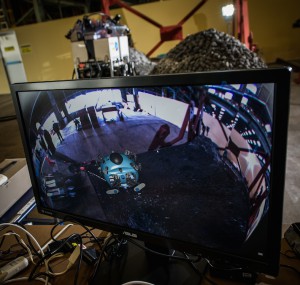As automakers move toward production of autonomous vehicles, many wonder about the pros and cons of this kind of technology. Many have visions of simply getting behind the wheel and order their car to take them to work.
However, Nissan’s iteration of a self-driving vehicle may lead some riders on a trip they may not have expected until recently: the bottom of the sea. While there are many concerns about what happens when an autonomous vehicle “runs wild,” a Jacques Cousteau-like experience isn’t really on the list.
In short, forget about the think making you car sick, it’s sea sickness that should be a concern! Nissan is using part of its self-driving technology to help explore the depths of the ocean.
Nissan is providing its unique Around View Monitor (AVM) technology to the Japan Agency for Marine-Earth Science and Technology (JAMSTEC) and Topy Industries, Ltd., through a joint development project that may help uncover the mysteries of the oceans.
The joint development contract with JAMSTEC and Topy, one of the top manufacturers of robot crawlers in Japan, will enhance the government agency’s ability to search deep underwater for natural resources using remotely operated vehicles (ROVs).
Although AVM won’t recruit four birds to help ROV operators avoid obstacles on the ocean floor the same way it helped some guy park his Nissan Pathfinder in 2013 commercial, but it will act as a “third eye” to help them be more efficient when creeping along in the darkest depths, officials suggest.
“We conduct many types of research, such as placing and recovering observational equipment on the ocean floor,” said Yoshitaka Nanbu, assistant group leader, Marine Technology & Engineering Center, JAMSTEC.
(That autonomous vehicle may make you car sick. For more, Click Here.)
“Today, we can only get two-dimensional images. This makes it hard to be precise and means we are not as efficient as we would like to be. If we could get a wider, 360-degree view, we think our task would be much easier and smoother.”
(Click Here for details about Nissan’s need for more U.S. capacity.)
AVM is one of the base technologies for Nissan’s autonomous drive vehicles, which the company aims to bring to market by 2020. First commercialized in 2007, AVM provides a virtual 360-degree overview of a car from a bird’s-eye view as pictured from above.
(To see more about Nissan and Honda trading potshots, Click Here.)
The technology helps drivers visually confirm the vehicle’s position relative to parking spaces and adjacent objects and maneuver into parking spots more easily. Nissan added Moving Object Detection (MOD) technology to AVM in 2011 and continues to develop other associated safety technologies, which will be vital in the development of a self-driving vehicle.
The AVM 3D function is combined with the ROV’s camera to improve measurement of distances on the ocean floor. This provides operators, controlling the ROVs aboard mother ships at sea, an overhead real-time bird’s-eye view of the remote vehicle and its immediate surroundings. The goal is to improve the efficiency of undersea searches by avoiding obstacles on the seabed with better real-time situational awareness.

